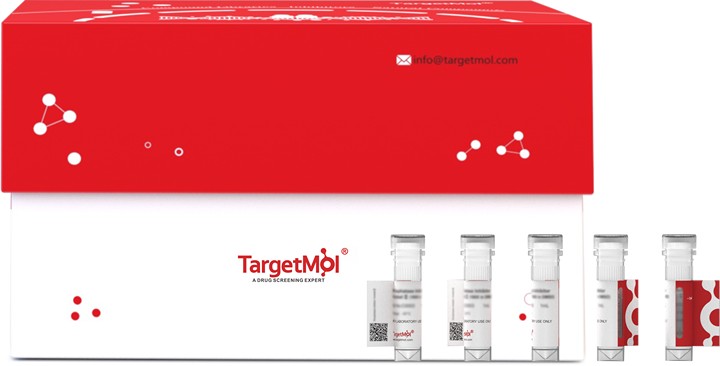 您的购物车当前为空
您的购物车当前为空
UBA6 Protein, Human, Recombinant (GST)
一键复制产品信息产品编号 TMPY-06748
UBA6 (Ubiquitin Like Modifier Activating Enzyme 6) is a Protein Coding gene. The UBA6 gene, located on 4q13.2, is conserved in chimpanzee, Rhesus monkey, dog, cow, mouse, rat, chicken, zebrafish, and frog. Uba6 is a homolog of the ubiquitin-activating enzyme, Uba1, and activates two ubiquitin-like proteins (UBLs), ubiquitin and FAT10. UBA6 is an alternative enzyme for ubiquitin activation in vertebrates that plays a pivotal role in early mouse development. UBA6 is widely expressed in the lymph node, appendix, and other tissues. Diseases associated with UBA6 include Ichthyosis, Congenital, Autosomal Recessive 4A, and Johanson-Blizzard Syndrome. Among its related pathways are the Metabolism of proteins and the Innate Immune System.

UBA6 Protein, Human, Recombinant (GST)
一键复制产品信息产品编号 TMPY-06748
UBA6 (Ubiquitin Like Modifier Activating Enzyme 6) is a Protein Coding gene. The UBA6 gene, located on 4q13.2, is conserved in chimpanzee, Rhesus monkey, dog, cow, mouse, rat, chicken, zebrafish, and frog. Uba6 is a homolog of the ubiquitin-activating enzyme, Uba1, and activates two ubiquitin-like proteins (UBLs), ubiquitin and FAT10. UBA6 is an alternative enzyme for ubiquitin activation in vertebrates that plays a pivotal role in early mouse development. UBA6 is widely expressed in the lymph node, appendix, and other tissues. Diseases associated with UBA6 include Ichthyosis, Congenital, Autosomal Recessive 4A, and Johanson-Blizzard Syndrome. Among its related pathways are the Metabolism of proteins and the Innate Immune System.
| 规格 | 价格 | 库存 | 数量 |
|---|---|---|---|
| 5 μg | ¥ 683 | 6-8日内发货 | |
| 10 μg | ¥ 1,130 | 6-8日内发货 | |
| 20 μg | ¥ 1,930 | 5日内发货 | |
| 50 μg | ¥ 3,820 | 5日内发货 | |
| 100 μg | ¥ 6,730 | 5日内发货 | |
| 200 μg | ¥ 11,800 | 5日内发货 | |
| 500 μg | ¥ 28,800 | 5日内发货 |
大包装 & 定制
加入购物车
TargetMol 的所有产品仅用作科学研究或药证申报,不能被用于人体,我们不向个人提供产品和服务。请您遵守承诺用途,不得违反法律法规规定用于任何其他用途。
资源下载
产品信息
| 生物活性 | Activity testing is in progress. It is theoretically active, but we cannot guarantee it. If you require protein activity, we recommend choosing the eukaryotic expression version first. |
| 产品描述 | UBA6 (Ubiquitin Like Modifier Activating Enzyme 6) is a Protein Coding gene. The UBA6 gene, located on 4q13.2, is conserved in chimpanzee, Rhesus monkey, dog, cow, mouse, rat, chicken, zebrafish, and frog. Uba6 is a homolog of the ubiquitin-activating enzyme, Uba1, and activates two ubiquitin-like proteins (UBLs), ubiquitin and FAT10. UBA6 is an alternative enzyme for ubiquitin activation in vertebrates that plays a pivotal role in early mouse development. UBA6 is widely expressed in the lymph node, appendix, and other tissues. Diseases associated with UBA6 include Ichthyosis, Congenital, Autosomal Recessive 4A, and Johanson-Blizzard Syndrome. Among its related pathways are the Metabolism of proteins and the Innate Immune System. |
| 种属 | Human |
| 表达系统 | Baculovirus Insect Cells |
| 标签 | N-GST |
| 蛋白编号 | A0AVT1 |
| 别名 | ubiquitin-like modifier activating enzyme 6,UBE1L2,MOP-4,E1-L2 |
| 蛋白构建 | A DNA sequence encoding the Human UBA6 (A0AVT1) (Met1-Asp1052) was expressed with an N-terminal GST tag. Predicted N terminal: Met |
| 蛋白纯度 | ≥ 80 % as determined by SDS-PAGE. |
| 分子量 | 143.56 kDa (predicted); 117.02 kDa (reducing conditions) |
| 内毒素 | < 1.0 EU/μg of the protein as determined by the LAL method. |
| 蛋白性状 | Lyophilized powder |
| 缓冲液 | Lyophilized from a solution filtered through a 0.22 μm filter, containing 20 mM Tirs, 500 mM Nacl, 10% glycerol, 0.5 mM PMSF, 0.5 mM TCEP, 2 mM GSH, pH 7.5. Typically, a mixture containing 5% to 8% trehalose, mannitol, and 0.01% Tween 80 is incorporated as a protective agent before lyophilization. |
| 复溶方法 | A Certificate of Analysis (CoA) containing reconstitution instructions is included with the products. Please refer to the CoA for detailed information. |
| 存储 | It is recommended to store recombinant proteins at -20°C to -80°C for future use. Lyophilized powders can be stably stored for over 12 months, while liquid products can be stored for 6-12 months at -80°C. For reconstituted protein solutions, the solution can be stored at -20°C to -80°C for at least 3 months. Please avoid multiple freeze-thaw cycles and store products in aliquots. |
| 运输方式 | In general, Lyophilized powders are shipping with blue ice. |
| 研究背景 | UBA6 (Ubiquitin Like Modifier Activating Enzyme 6) is a Protein Coding gene. The UBA6 gene, located on 4q13.2, is conserved in chimpanzee, Rhesus monkey, dog, cow, mouse, rat, chicken, zebrafish, and frog. Uba6 is a homolog of the ubiquitin-activating enzyme, Uba1, and activates two ubiquitin-like proteins (UBLs), ubiquitin and FAT10. UBA6 is an alternative enzyme for ubiquitin activation in vertebrates that plays a pivotal role in early mouse development. UBA6 is widely expressed in the lymph node, appendix, and other tissues. Diseases associated with UBA6 include Ichthyosis, Congenital, Autosomal Recessive 4A, and Johanson-Blizzard Syndrome. Among its related pathways are the Metabolism of proteins and the Innate Immune System. |
引用文献
技术支持
请阅读 重组蛋白用户指南 了解更多具体信息.





 |
|